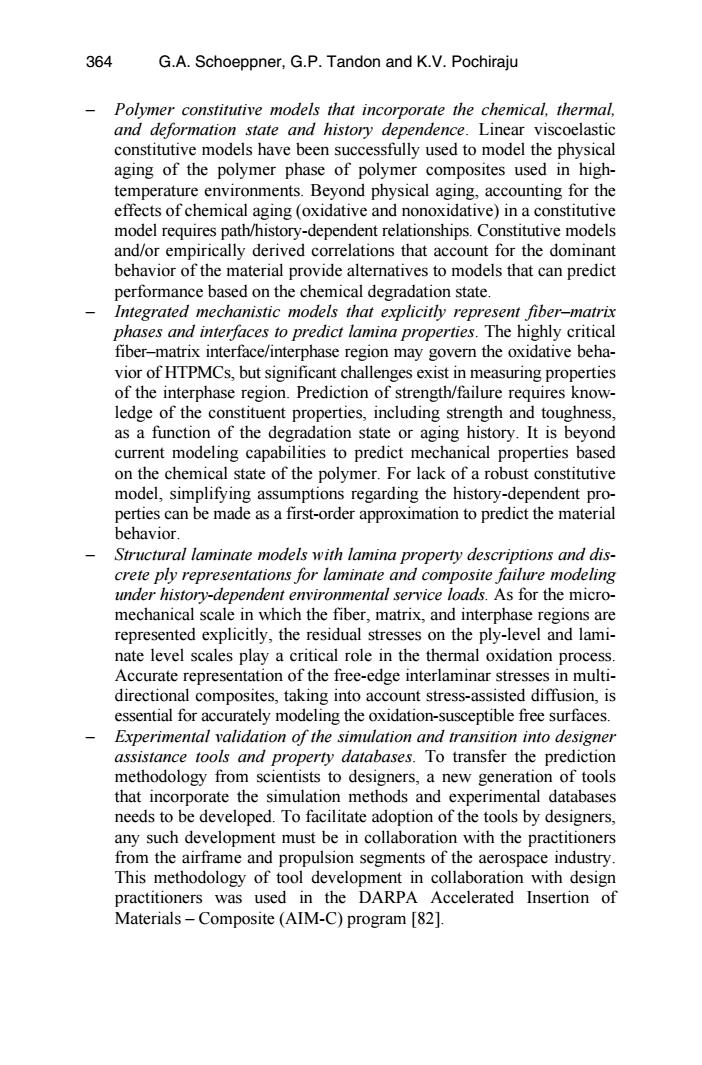正在加载图片...

364 G.A.Schoeppner,G.P.Tandon and K.V.Pochiraju Polymer constitutive models that incorporate the chemical,thermal, and deformation state and history dependence.Linear viscoelastic constitutive models have been successfully used to model the physical aging of the polymer phase of polymer composites used in high- temperature environments.Beyond physical aging,accounting for the effects of chemical aging(oxidative and nonoxidative)in a constitutive model requires path/history-dependent relationships.Constitutive models and/or empirically derived correlations that account for the dominant behavior of the material provide alternatives to models that can predict performance based on the chemical degradation state. Integrated mechanistic models that explicitly represent fiber-matrix phases and interfaces to predict lamina properties.The highly critical fiber-matrix interface/interphase region may govern the oxidative beha- vior of HTPMCs,but significant challenges exist in measuring properties of the interphase region.Prediction of strength/failure requires know- ledge of the constituent properties,including strength and toughness as a function of the degradation state or aging history.It is beyond current modeling capabilities to predict mechanical properties based on the chemical state of the polymer.For lack of a robust constitutive model,simplifying assumptions regarding the history-dependent pro- perties can be made as a first-order approximation to predict the material behavior. Structural laminate models with lamina property descriptions and dis- crete ply representations for laminate and composite failure modeling under history-dependent environmental service loads.As for the micro- mechanical scale in which the fiber,matrix,and interphase regions are represented explicitly,the residual stresses on the ply-level and lami- nate level scales play a critical role in the thermal oxidation process. Accurate representation of the free-edge interlaminar stresses in multi- directional composites,taking into account stress-assisted diffusion,is essential for accurately modeling the oxidation-susceptible free surfaces. Experimental validation of the simulation and transition into designer assistance tools and property databases.To transfer the prediction methodology from scientists to designers,a new generation of tools that incorporate the simulation methods and experimental databases needs to be developed.To facilitate adoption of the tools by designers, any such development must be in collaboration with the practitioners from the airframe and propulsion segments of the aerospace industry. This methodology of tool development in collaboration with design practitioners was used in the DARPA Accelerated Insertion of Materials-Composite(AIM-C)program [82].– Polymer constitutive models that incorporate the chemical, thermal, and deformation state and history dependence. Linear viscoelastic constitutive models have been successfully used to model the physical aging of the polymer phase of polymer composites used in hightemperature environments. Beyond physical aging, accounting for the effects of chemical aging (oxidative and nonoxidative) in a constitutive model requires path/history-dependent relationships. Constitutive models and/or empirically derived correlations that account for the dominant behavior of the material provide alternatives to models that can predict performance based on the chemical degradation state. – Integrated mechanistic models that explicitly represent fiber–matrix phases and interfaces to predict lamina properties. The highly critical fiber–matrix interface/interphase region may govern the oxidative behavior of HTPMCs, but significant challenges exist in measuring properties of the interphase region. Prediction of strength/failure requires knowledge of the constituent properties, including strength and toughness, as a function of the degradation state or aging history. It is beyond current modeling capabilities to predict mechanical properties based on the chemical state of the polymer. For lack of a robust constitutive model, simplifying assumptions regarding the history-dependent properties can be made as a first-order approximation to predict the material behavior. – Structural laminate models with lamina property descriptions and discrete ply representations for laminate and composite failure modeling under history-dependent environmental service loads. As for the micromechanical scale in which the fiber, matrix, and interphase regions are represented explicitly, the residual stresses on the ply-level and laminate level scales play a critical role in the thermal oxidation process. Accurate representation of the free-edge interlaminar stresses in multidirectional composites, taking into account stress-assisted diffusion, is essential for accurately modeling the oxidation-susceptible free surfaces. – Experimental validation of the simulation and transition into designer assistance tools and property databases. To transfer the prediction methodology from scientists to designers, a new generation of tools that incorporate the simulation methods and experimental databases needs to be developed. To facilitate adoption of the tools by designers, any such development must be in collaboration with the practitioners from the airframe and propulsion segments of the aerospace industry. This methodology of tool development in collaboration with design practitioners was used in the DARPA Accelerated Insertion of Materials – Composite (AIM-C) program [82]. 364 G.A. Schoeppner, G.P. Tandon and K.V. Pochiraju